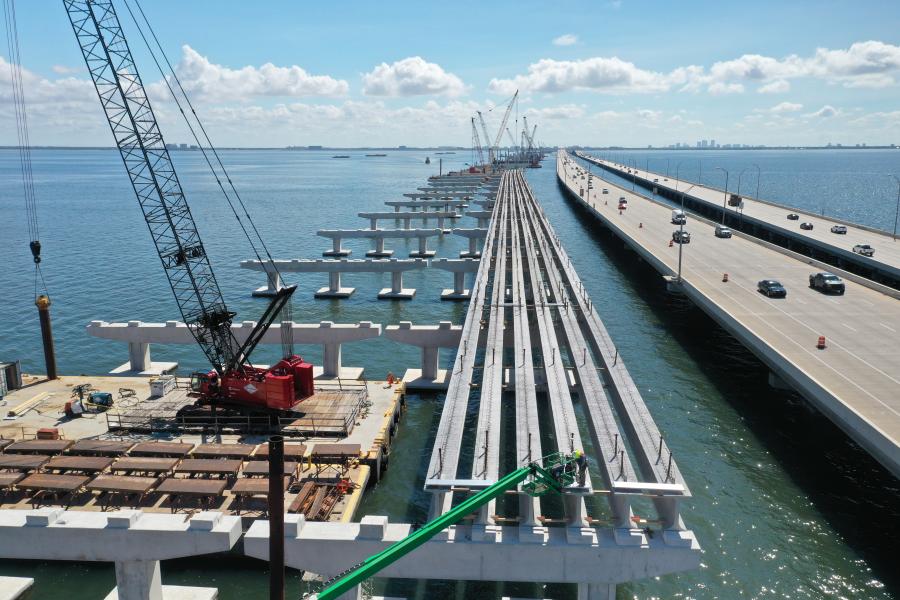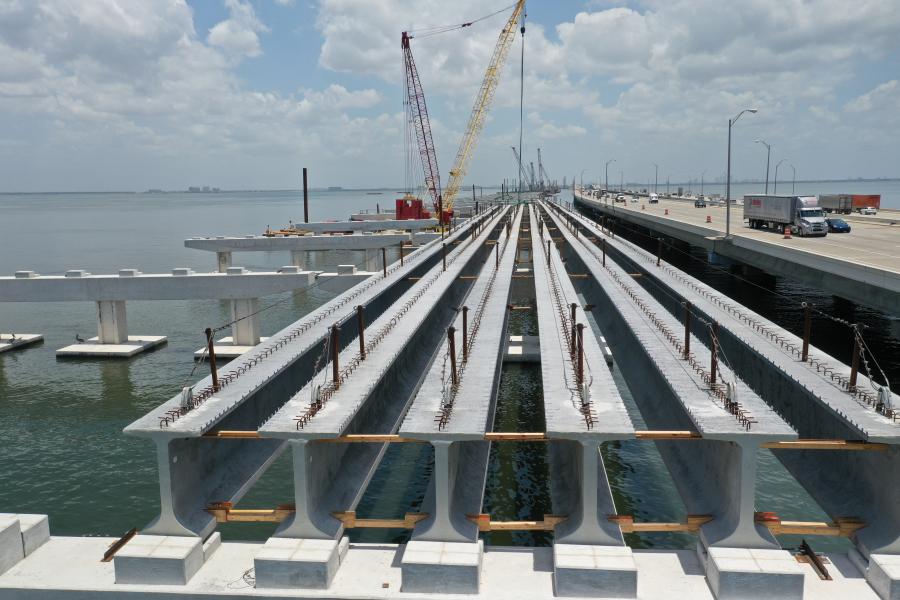“The lengths of the piles are almost impossible to predict,” said Bill Jeffries, project administrator, HFB Replacement. “For example, we have had a pile in a footing achieve capacity at 72 feet, and the pile next to it, six feet away, did not achieve capacity until 220 feet.” (Florida DOT photo)
More than 80 barges and two dozen cranes dot the watery landscape, as construction crews continue work on Florida's $865 million Howard Frankland Bridge (HFB) replacement project. The new bridge is being built to the north of the current southbound bridge and will consist of eight lanes that include four general purpose lanes, two northbound express lanes, two southbound express lanes and a bicycle/pedestrian path. The existing southbound bridge will be converted to become northbound I-275, and the existing northbound I-275 bridge will be removed as part of the multi-year effort.
"While navigating the numerous entities and agencies that are involved does present a challenge, this JV [a joint venture between Archer Western and Traylor Bros.] and Atkins team are both well suited for the task," said Bill Jeffries, project administrator, HFB Replacement. "Like any project, we have had our obstacles, but it's coming along nicely.
"As part of the department's large work program for the area, this project will add much-needed capacity for the entire region. We are proud to be delivering this high-profile project for the Florida Department of Transportation [FDOT] and the residents of Tampa Bay."
The aging HFB provides a crucial link between Pinellas and Hillsborough counties and serves as the central bridge spanning Old Tampa Bay from Clearwater/St. Petersburg to Tampa. The structure is the most traveled of the Bay Area bridges, carrying an average of 179,5000 vehicles per day across Tampa Bay. It is one of three bridges connecting Pinellas and Hillsborough counties, the others being the Gandy Bridge and the Courtney Campbell Causeway.
According to FDOT, the new bridge design will improve incident management in emergency response situations, addressing safety concerns raised by the community during the outreach process, including hurricane evacuations.
"Currently, the project is anticipated to finish in late 2025," said Jeffries. "However, there are still many potential impacts to the project schedule outside of the contractor's control, such as hurricane seasons and material shortages."
Jeffries noted that, to date, the project has had little impact on the motoring public.
"In the future, there will be shifts in traffic patterns to accommodate different phases of the project. This team and our media partners do an excellent job making sure those changes are seamless, and that motorists are notified ahead of time."
The biggest challenges tied to the project involve foundation installation, due to the highly variable subsurface geology.
"The lengths of the piles are almost impossible to predict. For example, we have had a pile in a footing achieve capacity at 72 feet, and the pile next to it, six feet away, did not achieve capacity until 220 feet."
Jeffries noted that weather and safety are the primary concerns.
"The project has a robust severe weather management plan that's implemented for tropical storms and hurricanes to not only protect our assets, but the existing bridges, as well. Project management is constantly watching the weather every day to ensure the safety of our workforce. We use multiple weather alert systems to halt work activities for thunderstorms and high-wind events."
The project is 60 percent complete as far as foundation installation and 50 percent complete with substructure construction. Permanent causeway bulkheads are virtually finished. Completions of each bridge component, such as foundations, substructure and superstructure, are considered major milestones for the JV.
There are more than 1,700 girders and 2.7 million sq. ft. of bridge deck to construct. Currently, causeway embankment construction is taking place, along with foundation installation, substructure construction, superstructure girder erection and roadway construction on the Pinellas Causeway.
Regarding pedestals, pier caps and piling and footings, said Jeffries, "There are a lot of them. These elements are cast-in-place with concrete being delivered from the existing southbound bridge and conveyed to the point of placement with concrete buckets and cranes.
"Footing construction uses a precast soffit, with side steel forms that are suspended from the piles. The gaps around the piles are then sealed and water is pumped out. Next, the reinforcing steel cage is installed, and footing concrete is placed. The side steel forms are then removed, and the precast soffit is left behind."
Jeffries noted that pile and girders are being transported by barge to the job site from manufacturing facilities along the bay, south of the project. Prefabricated reinforcing steel for substructure elements also are moved by barge to their installation location. Concrete for substructure items, such as footings, columns and caps, is being delivered from the existing southbound bridge and conveyed to the installation point by crane and bucket.
As for converting the existing southbound/westbound (Tampa to St. Petersburg) bridge to the new northbound/eastbound I-275 (St. Petersburg to Tampa), the new bridge will be opened to southbound traffic in two years.
"Rehab of expansion joints and concrete will occur on the existing southbound bridge before opening it to northbound traffic," said Jeffries. "This work is projected to be completed by the end of 2024. After converting the current southbound bridge to the northbound direction, the existing northbound bridge will be demolished."
During current construction, more than 500,000 cu. yds. of soil will be moved, as well as more than 100,000 tons of asphalt, more than 200,000 cu. yds. of concrete and more than 70 million lbs. of reinforcing steel.
Jeffries said foundation construction is the most time-consuming part of the work.
"We began driving pile in October 2020 and are projected to finish in the summer of 2023. There are more than 3,000 piles on the project."
The bicycle/pedestrian path will include four overlooks and aesthetic features that will be located at each end of the bridge and on the overlooks.
"Our portion of the path will be finished at the completion of the project, which is expected to be the end of 2025."
The hours can be long and there is still a significant amount of work remaining, but for Jeffries and the rest of the team, the investment is well worth it.
"It is definitely a highlight in most of our careers to be able to deliver a signature project of this stature to the residents of the Tampa Bay area." CEG
Cindy Riley
Birmingham, Ala., native Cindy RIley originally planned on a career in law, but during her sophomore year in college realized journalism was her true calling. A magna cum laude graduate of Samford University, Riley first worked in radio and TV. Named Best News Anchor, Best News Reporter and Best Investigative Reporter by the Associated Press, she interviewed numerous personalities, ranging from Dr. Henry Kissinger and President Bush to Michael Jordan and Captain Kangaroo.
As a print journalist, Riley has covered a variety of topics, including construction, business, health and the arts. In addition to CEG, her work has appeared in special reports for USA Today and the L.A. Times. Other publications have included New South Magazine, Portico, Thicket, Alabama Heritage, B-Metro, Business First and Birmingham Business Journal.
Read more from Cindy Riley here.
Today's top stories





















